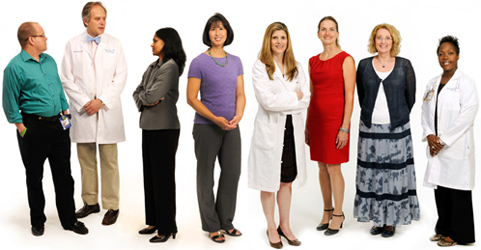Serving our patients
See captions below.
|
In this report
1. At the Grady Ponce Center, one of the largest HIV clinics in the country, Emory physicians work hand in glove with Emory nursing faculty like Marcia Holstad. 2. Infectious disease specialist Wendy Armstrong directs the center, where relationships with patients are at the heart of care and research. and Grady nurses like Katie Houston. 3. Neurologist Greg Esper, nurse Sandra Fields, and LPN Michele Shepherd-Tigner work together in a new neurology clinic program that combines related specialties to identify and solve patient problems. 4. In collaboration with Children’s Healthcare of Atlanta, neonatologist Ira Adams-Chapman is part of a team providing follow-up care in a developmental progress clinic for children born prematurely. 5. Radiation oncologist Ian Crocker and Tim Fox, director of medical physics at Winship Cancer Institute, will play major roles in Georgia’s first proton therapy center, which will treat about 2,200 cancer patients when it opens in 2016 near Emory University Hospital Midtown. 6. Plastic surgeons with oral and maxillofacial surgeon Steven Roser (DeLos Hill Professor)—collaborations among multiple disciplines increase the odds of success as dramatically as advancing technology. 7. Transplant surgeons Kenneth Newell and Allan Kirk (Georgia Research Alliance Eminent Scholar) with kidney donor Susanna Chavez and kidney recipient George Inzer—in living-donor kidney transplant, patients provide continual lessons in courage and generosity. |
As Emory Medicine continues to grow in reputation and geographic scope, so does the recognition that the success of our clinical, teaching, and research missions depends on how we work together and learn from others, including some unexpected partners.
Standardizing and extending intensive care
When it comes to teamwork, intensive care units (ICUs) involve the most sustained team effort in medicine, says Tim Buchman, director of the Emory Center for Critical Care (ECCC), which integrates the critical care units and staff—surgical, medical, cardiac, and neuro ICU beds—across all Emory Healthcare facilities. He’s the first to admit that it’s an archipelago of sites, as at most health care systems, but he and his colleagues are “federalizing” the multiple units in a model to ensure that quality, value, and access are the same wherever Emory faculty practice. This effort also provides a great opportunity to pull together the people, tools, knowledge, and operations to be able to predict prognoses as accurately as the weather and respond accordingly with efforts to prevent, forestall, and mitigate crises in patient conditions.
And not a moment too soon, says Buchman, as an aging population puts increasing demand on critical care programs. That’s why Emory is leading efforts to build a collaborative network supporting ICUs in rural and underserved North Georgia communities. The ECCC received a $10.7 million innovations award from the Centers for Medicare and Medicaid Services to combine specialty training for community nurse practitioners, physician assistants, and other clinicians with telemedicine intensive care services, allowing remote support, advice, and supervision by experienced critical care doctors and nurses. EmoryHealthcare is partnering with Saint Joseph’s Health System, Northeast Georgia Health System, Southern Regional Medical Center, and telemedicine provider Philips.
Beyond traditional therapy for HIV/AIDS
When combination retroviral therapy first appeared on the scene in the 1990s (with one of the most widely used drugs an Emory discovery), many thousands of HIV/AIDS patients were brought back from the brink of death. At Atlanta’s Ponce Center, a part of Grady Health System staffed by Emory doctors and researchers, the goal is to ensure that the most vulnerable patients don’t turn their backs, for psycho-socio-economic reasons, on the lifesaving therapies now available. One of the country’s largest and oldest AIDS clinics, the center serves about 5,200 persons each year. Staff go into the community and take steps to find affected persons and then link and retain them in care. As a core facility for Emory’s NIH-funded Center for Aids Research, with more than 50 studies currently in process, what is learned here improves clinical care for patients across the country.
What works best, research confirms, is personal attention, with close ties to clinicians and staff strongly encouraged. In the Transition Center, a sub-clinic for patients struggling with the triple whammy of HIV, mental illness, and substance abuse, patients stayed more engaged and demonstrated significant decreases in viral loads when they felt they had a close relationship with their place of care and their care provider. Based on this data, Emory researchers designed Project Retain to create retention clinics for newly diagnosed patients, using personal navigators to help patients work out logistics of treatment.
NCI renewal for Winship
The National Cancer Institute rated Emory’s Winship Cancer Institute outstanding in its five-year renewal of Winship’s status as an NCI-designated facility, accompanied by $7.5 million in funding. Reasons for the renewal included a world-class multiple myeloma program, advances in lung cancer research and treatment, one of the nation’s oldest and finest leukemia and bone marrow transplant programs, the Southeast’s largest head and neck cancer research effort, and a broad portfolio of cancer clinical trials. The reviewers also noted Winship’s facilities and its strong cancer genetics and cell biology science, drug development, and efforts in cancer prevention.
Intentional design
Three years ago, after watching the already finely tuned Emory Transplant Center develop new processes to help ensure best possible quality and consistency of patient outcomes, Emory Clinic administrators turned likewise to the Afterburner Group, consultants grounded in the high-risk, highly complex aviation industry. The group’s detailed cycle of planning, training, briefing, executing, debriefing, and re-planning is changing operating procedures across Emory’s patient enterprise, involving every member of the team, from clinicians who see patients to the people who check them in or send out their lab results or invoices.
But fine-tuning reliability of performance and adherence to protocols is just one part of ongoing efforts to improve the patient experience. The most visible effort, no doubt, is construction beginning on the new nine-story, 270-bed wing of Emory University Hospital (EUH) and ongoing renovation of existing clinic facilities, based on suggestions from the clinicians who work there and a committee of current and former patients and families who know the health care experience firsthand.
Some changes are as simple as wider doors and added seating for families in exam rooms. More complex changes include redesign of floors so patients move easily among related disciplines. The most far-reaching change? Continued growth, with more than 200 affiliated practices throughout Atlanta and Georgia.

Clinical integration
Emory Healthcare’s new clinically integrated network (CIN) received its first major external endorsement this year, with a contract to provide care to patents covered by Blue Cross Blue Shield of Georgia, the largest payer in the state. A CIN is a network of physicians and hospitals formed to improve care coordination to improve quality outcomes and manage costs more efficiently. The Emory CIN will support providers’ gradual transition from episodic, fee-for-service care to management of patients as a population, with increased focus on care coordination and prevention. Emory Healthcare’s new health information exchange will allow all CIN members to exchange electronic clinical information to coordinate care and facilitate analysis of data to support continuous improvement activities.
Leaders in stroke care
Both Emory University Hospital (EUH) and Grady Hospital (where Emory faculty provide care) received Advanced Comprehensive Stroke Center certification in the past year. The new Joint Commission rating, the highest possible, recognizes institutions with specialists, programs, and clinical resources to treat stroke patients of any complexity, around the clock, with accuracy and speed. EUH Midtown, Emory Johns Creek Hospital, and Saint Joseph’s Hospital are now Advanced Primary Stroke Centers. Emory physicians treat roughly a fourth of the 20,000 stroke patients in the state.
 Uncommon transplants
Uncommon transplants
This past year, Emory surgeons performed Georgia’s first triple organ transplant, successfully transplanting a heart, liver, and kidney into a 38-year old mother of two. The former marathon runner’s congenital heart complications had resulted in heart failure, which then caused liver failure and kidney damage. Her only hope of living was a triple transplant, only 60 of which had been done in the United States. All three organs came from the same donor, and the two-day series of transplants in a critically ill patient was like a choreographed ballet. The patient spent three months battling complications in Emory University Hospital before going home to her family and renewed life.
Emory surgeons also participated in the world’s second largest kidney swap this past year. The chain involved 56 participants, facilitating 28 transplants in 19 centers. According to the National Kidney Registry, the chain illustrates the enormous progress being made to shorten set-up times for large swaps, reducing the time patients must wait for transplant.

